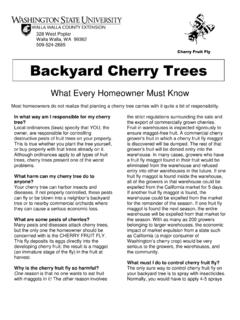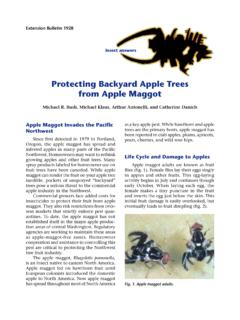Transcription of Technical guidelines on tropical fruit tree management in ...
1 October 2010 Giuseppe De BacProject GCP/ETH/073/ITAT echnical guidelines on tropical fruit tree management in EthiopiaCooperaz onetalianaiSviluppoallo1 Technical guidelines on tropical fruit tree management in EthiopiaNURSERY CARE AND GRAFTINGThe success of failure of an orchard is largely dependent on how well the propagating and growing of fruit trees has been done in the early stage, therefore proper nursery care is individual grower in most of the cases does not produce his own plants, although if nursery plants are not available, it will be forced by the circumstances to do nursery should be located in an area which is climatically suitable for the species being requires deep, well drained soil for growing seedlings in suitable conditions, pref-erably in polyethylene bags. 2 Technical guidelines on tropical fruit tree management in EthiopiaA reliable water source that guarantee water all year round is the site has been selected, propagation structure should be erected.
2 After the layout is complete, areas to be used for propagation beds and filed areas for the production of filed stock (plants grown in the ground as opposed to those grown in plastic plant bags or other containers) should be tested for nematodes and, if necessary, fumigated with methyl bromide, EDB (ethylene dibromide), or some other fumigant. Even if nematodes are not a problem, the fumigation of nursery beds is desirable as a control for soil-borne disease and simple shade structure can be constructed by using poles to support a roof of wire mesh upon which a thin layer of thatching grass or a black shade net is tied to give filtered sunlight beneath. This type of structure (especially if also provided with grass walls) can be used to propagate many species of fruit crops and can also be used for growing newly transplanted stock.
3 Poles should be treated with a wood preservative to prevent rotting and termite damage. Creosote may be used below ground level but should not be used above ground as it gives off fumes which are toxic to plants. Copper-containing preserva-tives such as copper naphthenate are ideal if they are available. If these materials are not obtainable, soak the bottom of the poles in paraffin (kerosene) so that the poles are protected to 15cm above the soil level. Potting soilsGood quality potting soil mixes for containers is a must to growth successfully a first prerequisite is to guarantee a media free from nematode, insects and pathogens. To do so, it is always recommended to kill the pathogen using fumigation (chemicals) or high temperatures (heat) through solarisation (put 20cm layer of soil mix under a plastic thin foil and under the sun), or heating a drum full of soil with firewood.
4 The soil mix should therefore ideally be taken from virgin land (forest) it should be rich in organic matter and should also have a good percentage of sand which can improve drainage and aeration. However, the best soils for a potting mix are sandy loams taken from the top 15cm below a grass cover. To obtain good quality mango and avocado trees, seedlings are generally grafted in their early stage, using cleft technique; But what is grafting, and why it is is a form of propagation, which involves the union of two separate woody pieces. 3 Technical guidelines on tropical fruit tree management in EthiopiaThe upper part is the scion , which combines with the stock (lower part). The stock and the scion must belong to the same species or to the same family, to guarantee success in the union . Grafting is executed to combine the quality of two plants.
5 It could be done to ameliorate the quality of a plant and strengthen the plants against propagation is carried out by seeds there is no guarantee that the desired character will appear in the offspring. When grafting is successful, the quality of the plants from which the scion is taken are enhanced by the vigour of the plant which serves as the listed are the main common grafting techniques for mango and avocado prop-agation: Cleft grafting. The steps in cleft grafting are as follows: (see Fig.).Wipe any soil or debris adhering to the stem of the Cut back the stock to the point where there is active growth or where the bark easily separates from the wood. Leave 2 or more leaves intact below the cut. Cut the stock down the centre deep enough to hold the Choose a scion with a diameter as big as the Cut the scion to a length of 10-15 Shape its base into a short wedge (about 2-3 cm).
6 E. Insert the scion to the stock with care to line up the junction between bark and wood of the Tie the graft with , grafting tapeg. Cover the union with grafting wax or waterproof material4 Technical guidelines on tropical fruit tree management in Ethiopia5 Technical guidelines on tropical fruit tree management in Ethiopia6 Technical guidelines on tropical fruit tree management in EthiopiaAPPROACH GRAFTING TECHNIQUE-In this grafting technique scion is not cut from its root so that when the union of the two parts is carried out photosynthesis process continue on both scion and stock until the graft has : thin layer of bark is shaved off on both scion and stock. the stock and scion are joined the graft is tied and covered with grafting wax or other waterproof material after the graft has healed the scion is separated from its root by cutting just below the graft and the remaining shoots of the stock is guidelines on tropical fruit tree management in EthiopiaTop WorkingIt is used on mature plants which are to be change in a different cultivar; this method should be limited to stock branches about , 10cm in diameter and to species with fairly straight-grained wood that will split evenly.
7 Cleft grafting can be done any time during the dormant season (dry season), but the chances for a good union are best if the work is done just before the active growth has initiated (just before raining season) and buds of the stock are beginning to swell. In making the cleft graft for top working the proper place-ment of the scions is very important. (See figure below).The scions should be made from one year-old wood. The scion is made by cutting a long, gradually tapering wedge. Preparing the stock it is important to split the stub deeply (even split). Two scions are inserted in the stub, one at each end of the split. The scions must be carefully placed so the cambium layers guidelines on tropical fruit tree management in EthiopiaCROP management OF SOME tropical fruit TREES9 Technical guidelines on tropical fruit tree management in EthiopiaAvocado (Persea Americana)Description of some varieties introduced in Ethiopia and presently availableCultivars AHass: high yielding.
8 Resistant to main pests and diseases. Not presenting a marked bi-ennial fruiting behaviour. fruit size variable; oil % in the fruit : medium, month to ripen: 9, seed size: small; cold tolerance: medium Pinkerton: high yielding; fruit size; medium; oil % in the fruit : high; month to ripen: 6-8; seed size: big; cold tolerance: mediumCultivars BFuerte: a Mexican Guatemalan cross; medium yielding, fruit size , small to medium; oil % high; month to ripen 5-6;seed size : tolerant to frostBacon: high yielding; medium size fruit ; oil % high; tolerant to cold -5oCEttinger: A Mexican Guatemalan cross, resistant to cold -6oCNabal: Guatemalan type, big size fruit ; suitable for warm climateNursery care Seeds should be harvested from selected tree (not picked from the ground) and after removal of the pulp, care should be taken, in planting them as soon as possible in the nursery in order to avoid drying is common the infection of Phytophthora cinnamoni (avocado root rot) and to eliminate this fungus seeds should be sunk in hot water at 500C for 30 minutes before of the seed is hastened by removing the brown seed coats and cutting a thin slice from the apical and basal end of each seed before planting.
9 The seed coat can be removed by wetting the seeds and allowing them to dry in the seed should be placed in the soil with the large basal end down, just deep enough to cover the tips. Seedling should be ready for grafting after 5 -6 guidelines on tropical fruit tree management in EthiopiaThe propagation by seed-for rootstocks production it is a necessary step before grafting with improved varieties (taken from well identified mother plants). ShadeIn the nursery the seedlings are kept under partial shade. They should have been hard-ened before delivery. Where hardening has been inadequate it is advisable to protect the seedlings with temporary shade. As mentioned before, the stems should be white-washed. The leaves can also be protected by erecting a frame over the trees and cover-ing this with grass or shade net.
10 Once the leaves have penetrated with grass or shade net. Once the leaves have penetrated the grass they are hardened and need no further plant holePrior to planting, a hole should staked out and holes which are at least twice the diameter of the root ball must be soil should be placed in one pile and subsoil in hole should then be refilled with a mixture of 50 % top soil and 50 % of well rotten ma-nure, compost, or other decomposed organic matter. If this system is executed fertilizer application can be avoided during the first year of plant growth. The hole should be allowed to settle for two-three weeks before grown plants should be removed from their pots and any circling roots should be cut off in several places or loosen them. Soil is removed from the prepared holes and any stakes should be inserted firmly into the planting hole (to give support to the tree for the first two years); the plants are then set and covered to the same depth that they were growing in the container.
















